Mechanical and Microstructural Properties of HDPE Pipes Manufactured via Orbital Friction Stir Welding
Abstract
:1. Introduction
2. Materials and Methods
2.1. Materials
2.2. Methods
2.2.1. FSW Tool Development
2.2.2. Morphological Analysis of Joints
2.3. Joint Characterization
2.3.1. XRD
2.3.2. FTIR
2.3.3. SEM
2.3.4. Mechanical Properties
3. Results
3.1. Mechanical Properties of Joints
3.2. Joints Microstructural Analysis
3.2.1. XRD
3.2.2. FTIR
3.2.3. SEM
4. Conclusions
- The joining of HDPE pipes with desirable combinations of tensile and impact properties was successfully performed using the specially designed, portable, and heating-assisted FSW system.
- The proposed technique, utilizing a stationary shoe shoulder with a retractable tool pin, was able to fabricate sound joints without the appearance of tool exit hole defects.
- Microstructural observations of the stir-welded zone using XRD, FTIR, and SEM techniques revealed that the crystal structures of the FS-welded sample were similar to the base material, proving the reliability of the developed system.
- The samples welded with the optimum parameters presented comparable properties to the base materials and even a slight increase in the tensile strength (105%).
- The maximum impact strength was 2.45 kJ/m2, which represented about 89% of the base HDPE impact strength.
Author Contributions
Funding
Institutional Review Board Statement
Informed Consent Statement
Data Availability Statement
Acknowledgments
Conflicts of Interest
Nomenclature
| OFSW | Orbital friction stir welding |
| FSSW | Friction stir spot welding |
| HDPE | High density poly ethylene |
| PEEK | Poly-ether-ether-ketone |
| NBR | acrylonitrile-butadiene rubber |
| XRD | X-ray diffraction |
| FTIR | Fourier transform infrared spectroscopy |
| MWCNTs | Multiwalled carbon nanotubes |
| PA6 | Polyamide6 |
| ABS | Acrylonitrile butadiene styrene |
| HNTs | Halloysite nanotubes |
| RPT | Retractable Pin Tool |
| SDR | Section diameter ratio |
| SEM | Scanning electron microscope |
References
- Huang, Y.; Meng, X.; Xie, Y.; Li, J.; Si, X.; Fan, Q. Improving mechanical properties of composite/metal friction stir lap welding joints via a taper-screwed pin with triple facets. J. Mater. Process. Technol. 2019, 268, 80–86. [Google Scholar] [CrossRef]
- Khalid, H.U.; Ismail, M.C.; Nosbi, N. Permeation damage of polymer liner in oil and gas pipelines: A review. Polymers 2020, 12, 2307. [Google Scholar] [CrossRef] [PubMed]
- Azarsa, E.; Mostafapour, A. Experimental investigation on flexural behavior of friction stir welded high density polyethylene sheets. J. Manuf. Process. 2014, 16, 149–155. [Google Scholar] [CrossRef]
- Bindal, T.; Saxena, R.K.; Pandey, S. Analysis of joint overlap during friction spin welding of plastics. Mater. Today Proc. 2020, 26, 2798–2804. [Google Scholar] [CrossRef]
- Masuzawa, N.; Hori, K.; Ide, M. Ultrasonic welding of plastic pipes using torsional vibration. Jpn. J. Appl. Phys. 1998, 37, 3007. [Google Scholar] [CrossRef]
- Dell’Anna, R.; Lionetto, F.; Montagna, F.; Maffezzoli, A. Lay-up and consolidation of a composite pipe by in situ ultrasonic welding of a thermoplastic matrix composite tape. Materials 2018, 11, 786. [Google Scholar] [CrossRef] [PubMed] [Green Version]
- Mostafapour, A.; Azarsa, E. A study on the role of processing parameters in joining polyethylene sheets via heat assisted friction stir welding: Investigating microstructure, tensile and flexural properties. Int. J. Phys. Sci. 2012, 7, 647–654. [Google Scholar] [CrossRef]
- Rafati, M.; Mostafapour, A.; Laieghi, H.; Somani, M.C.; Kömi, J. Characterization of Friction Stir and TIG Welded CK45 Carbon Steel. Materials 2021, 14, 4098. [Google Scholar] [CrossRef]
- Alishavandi, M.; Ebadi, M.; Alishavandi, S.; Kokabi, A.H. Microstructural and mechanical characteristics of AA1050/mischmetal oxide in-situ hybrid surface nanocomposite by multi-pass friction stir processing. Surf. Coat. Technol. 2020, 388, 125488. [Google Scholar] [CrossRef]
- Laieghi, H.; Alipour, S.; Mostafapour, A. Investigation of the mechanical properties of friction stir welded PA6-based polymer nanocomposite and optimizing experimental conditions. Mater. Res. Express. 2019, 6, 065018. [Google Scholar] [CrossRef]
- Laska, A.; Szkodo, M. Manufacturing parameters, materials, and welds properties of butt friction stir welded joints–overview. Materials 2020, 13, 4940. [Google Scholar] [CrossRef] [PubMed]
- Bozkurt, Y. The optimization of friction stir welding process parameters to achieve maximum tensile strength in polyethylene sheets. Mater. Des. 2012, 35, 440–445. [Google Scholar] [CrossRef]
- Bilici, M.K.; Yükler, A.İ.; Kurtulmuş, M. The optimization of welding parameters for friction stir spot welding of high density polyethylene sheets. Mater. Des. 2011, 32, 4074–4079. [Google Scholar] [CrossRef]
- Lambiase, F.; Derazkola, H.A.; Simchi, A. Friction Stir Welding and Friction Spot Stir Welding Processes of Polymers—State of the Art. Materials 2020, 13, 2291. [Google Scholar] [CrossRef] [PubMed]
- Laieghi, H.; Alipour, S.; Mostafapour, A. Heat-assisted friction stir welding of polymeric nanocomposite. Sci. Technol. Weld. Join. 2019, 25, 56–65. [Google Scholar] [CrossRef]
- Gao, J.; Li, C.; Shilpakar, U.; Shen, Y. Improvements of mechanical properties in dissimilar joints of HDPE and ABS via carbon nanotubes during friction stir welding process. Mater. Des. 2015, 86, 289–296. [Google Scholar] [CrossRef]
- Lambiase, F.; Scipioni, S.I.; Lee, C.-J.; Ko, D.-C.; Liu, F. A state-of-the-art review on advanced joining processes for metal-composite and metal-polymer hybrid structures. Materials 2021, 14, 1890. [Google Scholar] [CrossRef]
- Chen, B.; Chen, K.; Hao, W.; Liang, Z.; Yao, J.; Zhang, L.; Shan, A. Friction stir welding of small-dimension Al3003 and pure Cu pipes. J. Mater. Process. Technol. 2015, 223, 48–57. [Google Scholar] [CrossRef]
- Lammlein, D.; Gibson, B.; DeLapp, D.; Cox, C.; Strauss, A.; Cook, G. The friction stir welding of small-diameter pipe: An experimental and numerical proof of concept for automation and manufacturing. Proc. Inst. Mech. Eng. B J. Eng. Manuf. 2012, 226, 383–398. [Google Scholar] [CrossRef]
- Hattingh, D.; Von Welligh, L.; Bernard, D.; Susmel, L.; Tovo, R.; James, M.N. Semiautomatic friction stir welding of 38 mm OD 6082-T6 aluminium tubes. J. Mater. Process. Technol. 2016, 238, 255–266. [Google Scholar] [CrossRef] [Green Version]
- Doos, Q.M.; Wahab, B.A. Experimental study of friction stir welding of 6061-T6 aluminum pipe. Int. J. Mech. Eng. Robot. Res. 2012, 1, 143–156. [Google Scholar] [CrossRef]
- Mosavvar, A.; Azdast, T.; Moradian, M.; Hasanzadeh, R. Tensile properties of friction stir welding of thermoplastic pipes based on a novel designed mechanism. Weld. World 2019, 63, 691–699. [Google Scholar] [CrossRef]
- Kaiyuan, C.; Nanqiao, Z.; Bin, L.; Shengping, W. Effect of vibration extrusion on the structure and properties of high-density polyethylene pipes. Polym. Int. 2009, 58, 117–123. [Google Scholar] [CrossRef]
- Zhang, M.; Xu, J.; Zhang, Z.; Zeng, H.; Xiong, X. Effect of transcrystallinity on tensile behaviour of discontinuous carbon fibre reinforced semicrystalline thermoplastic composites. Polymers 1996, 37, 5151–5158. [Google Scholar] [CrossRef]
- Alishavandi, M.; Mohammadmirzaei, M.; Ebadi, M.; Kokabi, A.H. Microstructural and mechanical evaluations of SAW by manufactured granular basic bonded Cr, Mo, and Cr–Mo active fluxes on ST37 low carbon steel. Int. J. Adv. Manuf. Technol. 2022, 119, 6335–6347. [Google Scholar] [CrossRef]
- Derazkola, H.A.; Simchi, A.; Lambiase, F. Friction stir welding of polycarbonate lap joints: Relationship between processing parameters and mechanical properties. Polym. Test. 2019, 79, 105999. [Google Scholar] [CrossRef]
- Lionetto, F.; Corcione, C.E.; Rizzo, A.; Maffezzoli, A. Production and Characterization of Polyethylene Terephthalate Nanoparticles. Polymers 2021, 13, 3745. [Google Scholar] [CrossRef]
- Liang, G.; Xu, J.; Bao, S.; Xu, W. Polyethylene/maleic anhydride grafted polyethylene/organic-montmorillonite nanocomposites. I. Preparation, microstructure, and mechanical properties. J. Appl. Polym. Sci. 2004, 91, 3974–3980. [Google Scholar] [CrossRef]



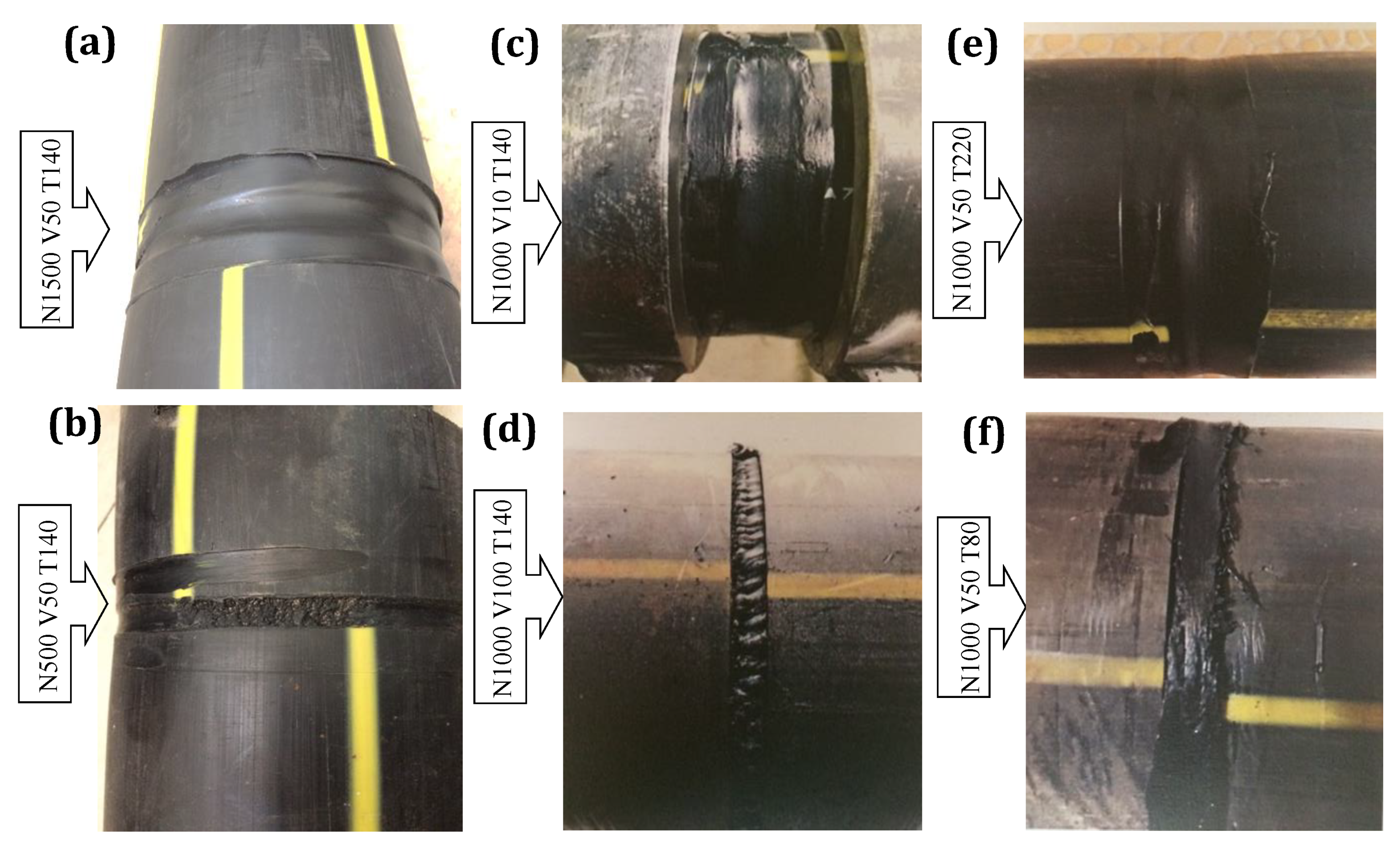
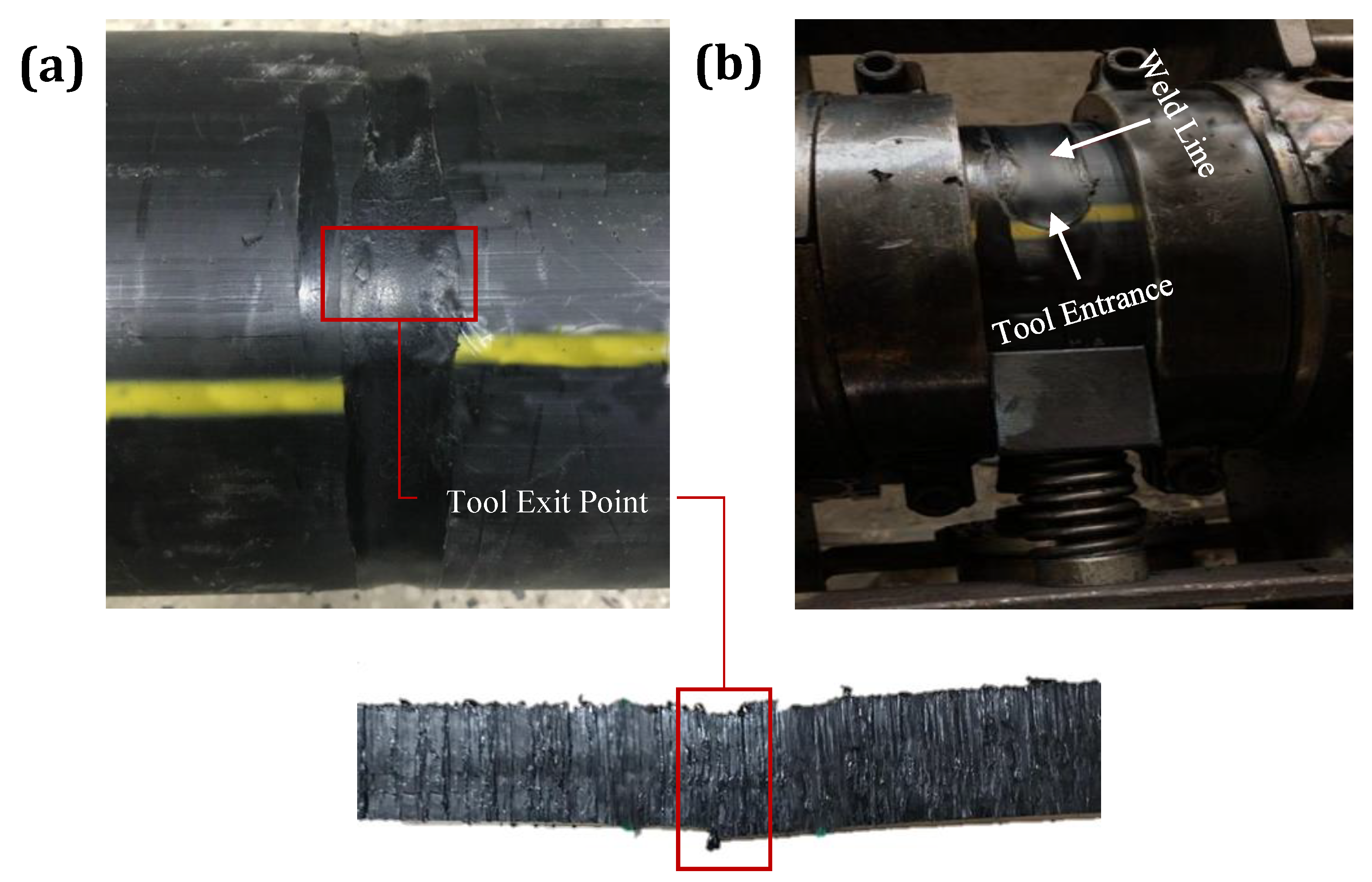
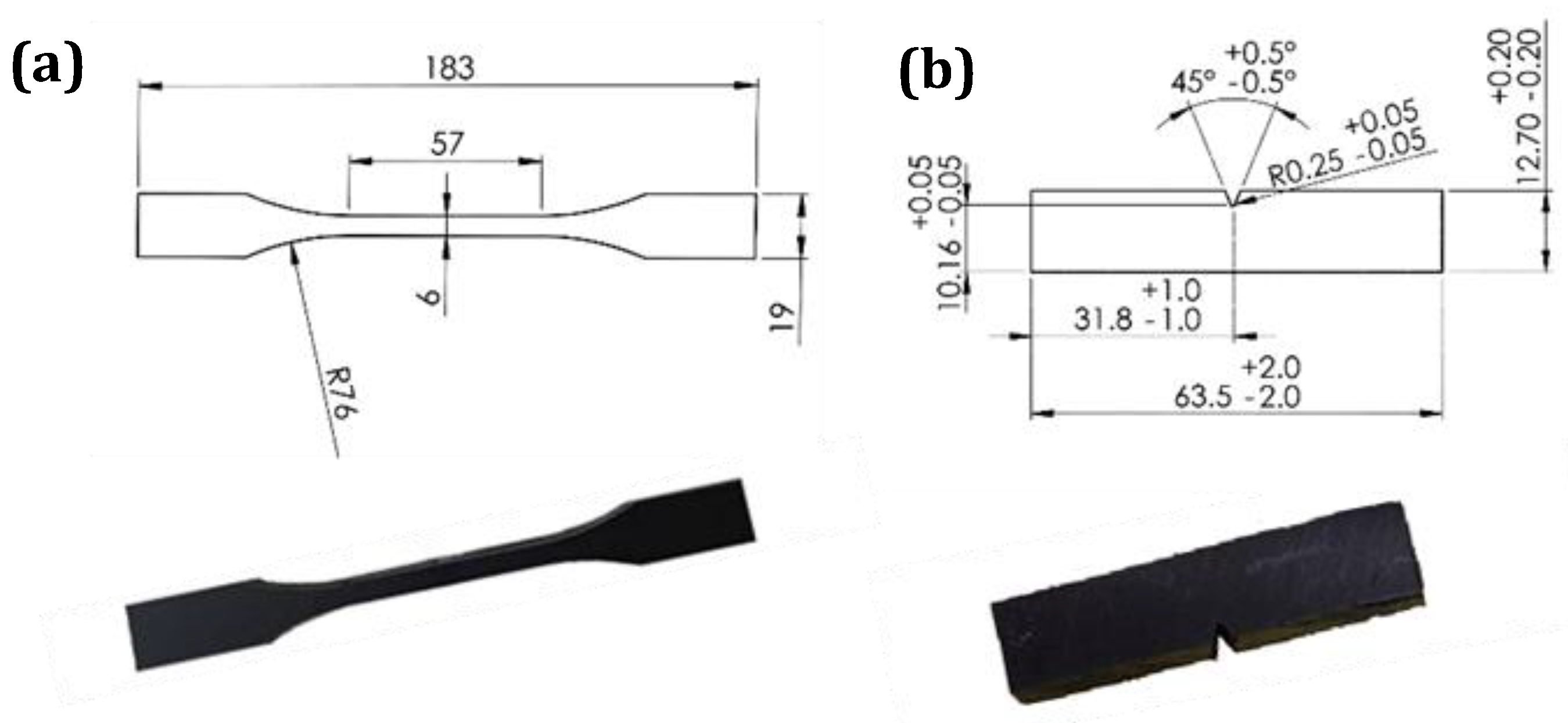

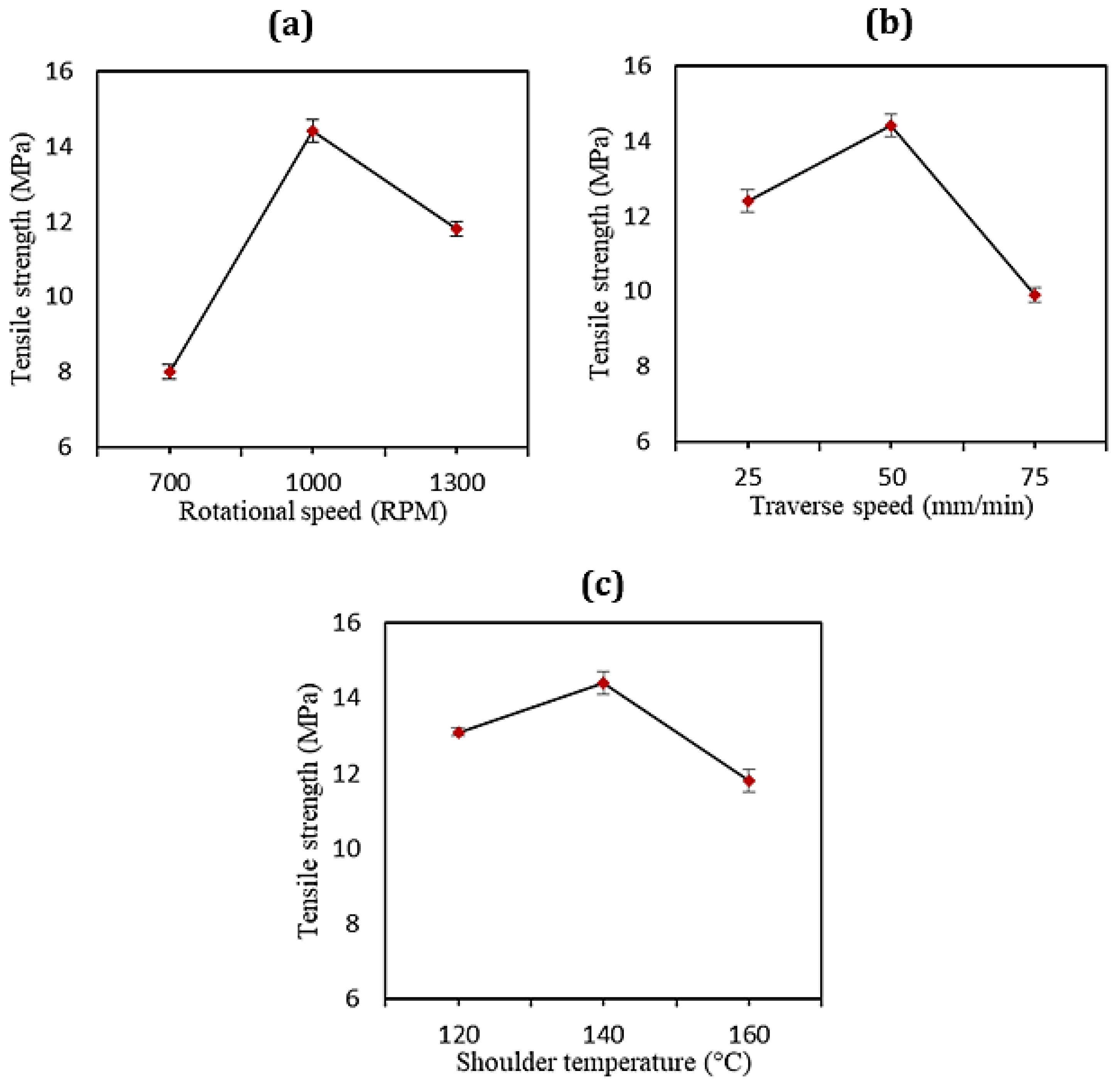

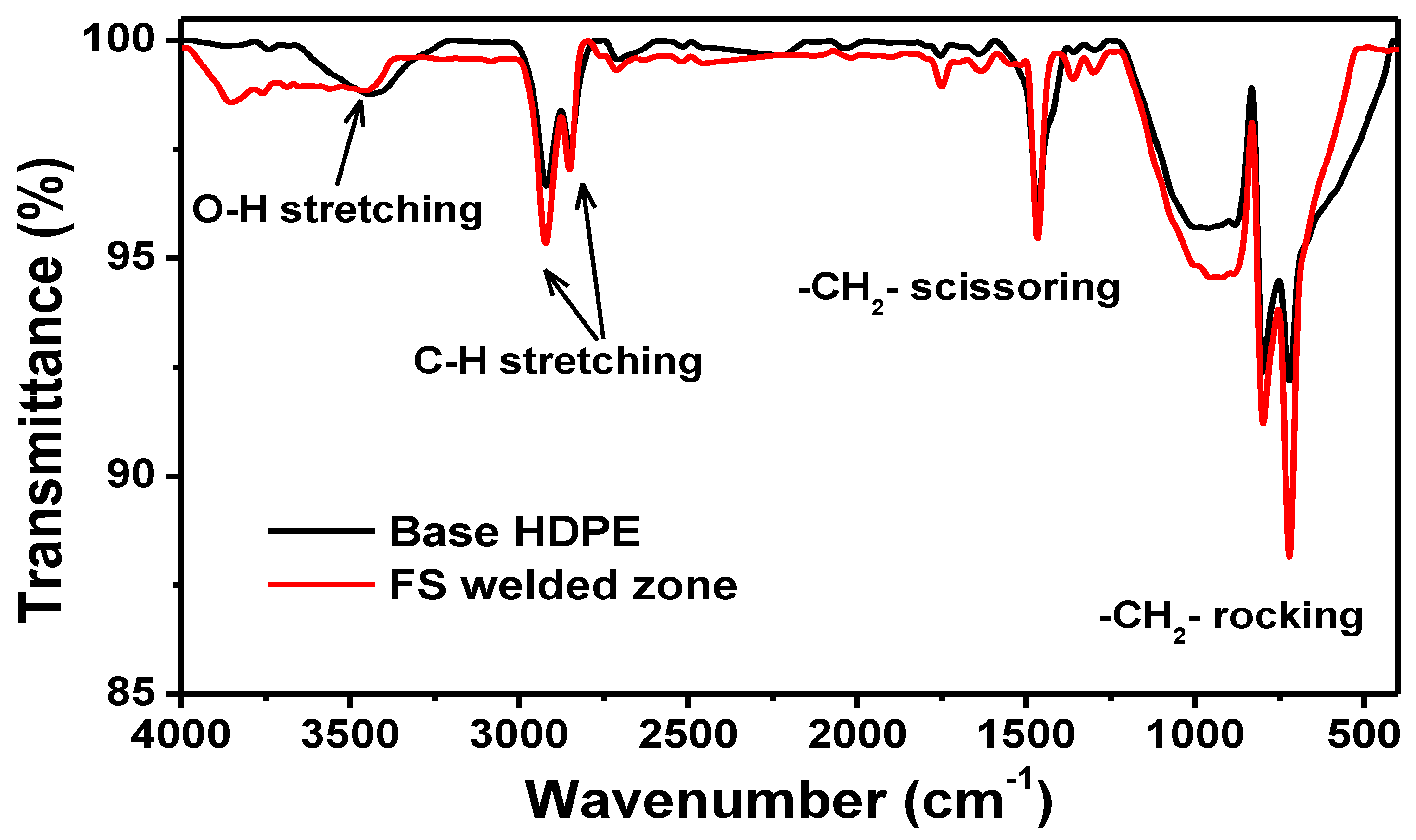
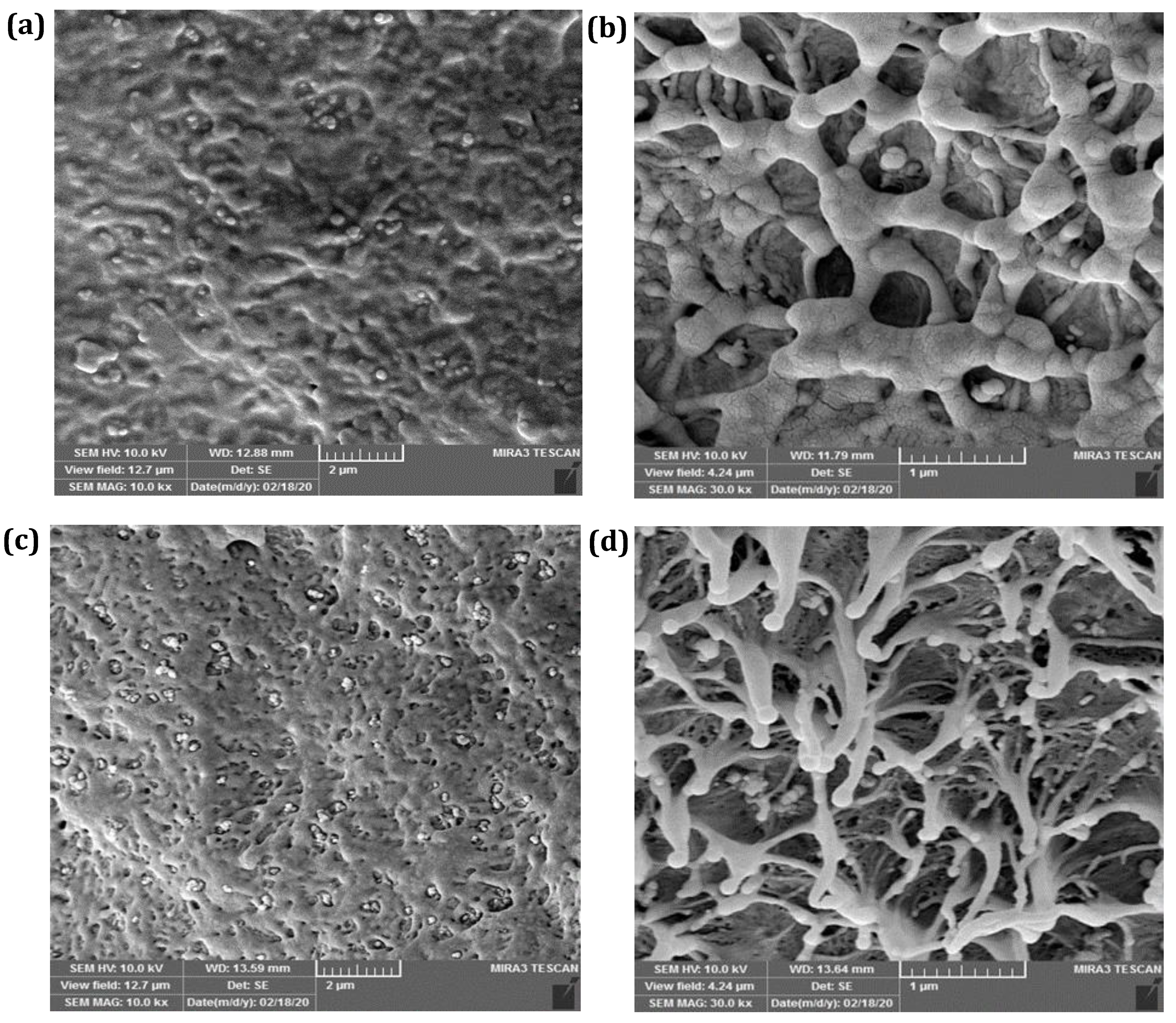
| Process Parameters | Rotational Speed (rpm) | Traverse Speed (mm/min) | Shoulder Temperature (°C) | Tool Tilt Angle | ||||||
|---|---|---|---|---|---|---|---|---|---|---|
| Unit level | L1 | L2 | L3 | L1 | L2 | L3 | L1 | L2 | L3 | constant |
| Unit value | 700 | 1000 | 1300 | 25 | 50 | 75 | 120 | 140 | 160 | 0° |
| Sample | Tool Rotation Rate (rpm) | Tool Traverse Speed (mm/min) | Shoulder Temperature (°C) | Tensile Strength (MPa) | Joint Efficiency (%) |
|---|---|---|---|---|---|
| Base Material | - | - | - | 13.6 | 100 |
| 1 | 700 | 50 | 140 | 8 ± 0.2 | 59 |
| 2 | 1000 | 25 | 140 | 12.4 ± 0.3 | 91 |
| 3 | 1000 | 50 | 140 | 14.4 ± 0.2 | 105 |
| 4 | 1000 | 75 | 140 | 9.9 ± 0.2 | 73 |
| 5 | 1000 | 50 | 120 | 13.1 ± 0.1 | 96 |
| 6 | 1000 | 50 | 160 | 11.8 ± 0.3 | 87 |
| 7 | 1300 | 50 | 140 | 10.8 ± 0.2 | 80 |
| Sample | XXRD (-) |
|---|---|
| Pure HDPE | 0.703 |
| FS-welded | 0.734 |
Publisher’s Note: MDPI stays neutral with regard to jurisdictional claims in published maps and institutional affiliations. |
© 2022 by the authors. Licensee MDPI, Basel, Switzerland. This article is an open access article distributed under the terms and conditions of the Creative Commons Attribution (CC BY) license (https://creativecommons.org/licenses/by/4.0/).
Share and Cite
Mehdikhani, H.; Mostafapour, A.; Laieghi, H.; Najjar, R.; Lionetto, F. Mechanical and Microstructural Properties of HDPE Pipes Manufactured via Orbital Friction Stir Welding. Materials 2022, 15, 3810. https://doi.org/10.3390/ma15113810
Mehdikhani H, Mostafapour A, Laieghi H, Najjar R, Lionetto F. Mechanical and Microstructural Properties of HDPE Pipes Manufactured via Orbital Friction Stir Welding. Materials. 2022; 15(11):3810. https://doi.org/10.3390/ma15113810
Chicago/Turabian StyleMehdikhani, Hesam, Amir Mostafapour, Hossein Laieghi, Reza Najjar, and Francesca Lionetto. 2022. "Mechanical and Microstructural Properties of HDPE Pipes Manufactured via Orbital Friction Stir Welding" Materials 15, no. 11: 3810. https://doi.org/10.3390/ma15113810







